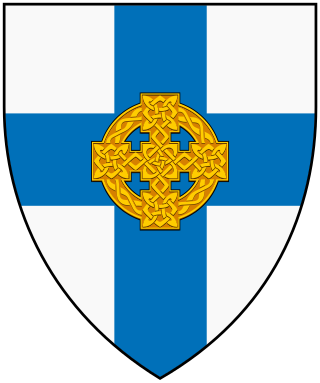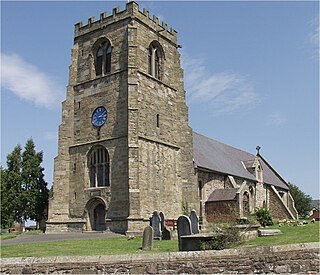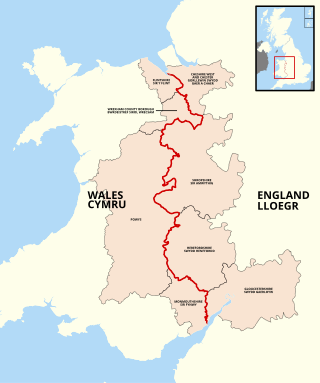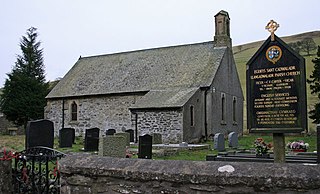
The Church in Wales is an Anglican church in Wales, composed of six dioceses.

Montgomery is a town and community in Powys, Wales. It is the traditional county town of the historic county of Montgomeryshire to which it gives its name and is within the Welsh Marches border area. The town centre lies about 1 mile (1.6 km) west of the England–Wales border. Montgomery Castle was started in 1223 and its parish church in 1227. Other locations in the town include The Old Bell Museum, the Offa's Dyke Path, the Robber's Grave and the town wall. The large Iron Age hill fort of Ffridd Faldwyn is sited northwest of the town and west of the Castle.

Llanymynech is a village and former civil parish straddling the border between Montgomeryshire/Powys, Wales, and Shropshire, England, about 9 miles (14 km) north of the Welsh town of Welshpool. The name is Welsh for "Church of the Monks". The village is on the banks of the River Vyrnwy, and the Montgomery Canal passes through it.

The Diocese of Saint Asaph is a diocese of the Church in Wales in north-east Wales, named after Saint Asaph, its second bishop.

The Welsh Church Act 1914 is an Act of Parliament under which the Church of England was separated and disestablished in Wales and Monmouthshire, leading to the creation of the Church in Wales. The Act had long been demanded by the Nonconformist community in Wales, which composed the majority of the population and which resented paying taxes to the Church of England. It was sponsored by the Liberal Party and opposed by the Conservative Party.

St Martin's is a village and civil parish in Shropshire, England, just north of Oswestry and east of Chirk, Wales on the England–Wales border.

Churchstoke or Church Stoke is a village, community and electoral ward in Montgomeryshire, Powys, Wales. Located in the southeast of the Vale of Montgomery, it is overlooked by Todleth Hill, Roundton Hill and Corndon Hill. The rivers Caebitra and Camlad have their confluence just outside the village. The nearest town is Montgomery. In the 2011 census the village had a population of 708.

The Bishop of St Asaph heads the Church in Wales diocese of St Asaph.

Llansilin is a village and local government community in Montgomeryshire, Powys, Wales, 5 miles (8 km) west of Oswestry. The community, which includes Llansilin village, a large rural area and the hamlets of Moelfre and Rhiwlas as well as the remote parish of Llangadwaladr, had a population of 648 at the 2001 census, increasing to 698 at the 2011 Census. There is also an electoral ward including the nearby village of Llanrhaeadr-ym-Mochnant with a population of 2,295.

Penley is a village in the County Borough of Wrexham, in Wales close to the border with Shropshire, England, and had a population of 606 as of the 2011 census.

The England–Wales border, sometimes referred to as the Wales–England border or the Anglo-Welsh border, runs for 160 miles (260 km) from the Dee estuary, in the north, to the Severn estuary in the south, separating England and Wales.

Llangadwaladr, formerly spelt Llancadwaladr in some sources, is an isolated mountain parish in Powys, Wales. It was formerly in the historic county of Denbighshire, and from 1974 to 1996 was in Clwyd. Some 7 miles west of the nearest town, Oswestry, it covers an area of sparsely settled hill farming country around the valley of the Afon Ysgwennant beneath Gyrn Moelfre.

Hyssington is a parish in the South-Eastern corner of the historic county of Montgomeryshire in Wales and borders the county of Shropshire in England. It is now within the area of the Church Stoke community council in Powys. It is dominated by Corndon Hill. The church which is in the Diocese of Hereford lies just the north of a small village and is sited just to the west of a medieval Motte-and-bailey castle. This area was also the source of late Neolithic and Early Bronze Age battle-axes and axe-hammers, made from picrite that were widely traded around 2000 BC.

The Welsh Church (Temporalities) Act 1919 is an act of the Parliament of the United Kingdom. It was made to provide for a grant to be made from the Treasury to enable the Welsh Church Commissioners to carry out their task and to set a date for the implementation of the disestablishment of the Church in Wales from the Church of England mandated by the Welsh Church Act 1914. Operation of this Act had been delayed by the Suspensory Act 1914, initially until 18 September 1915, and subsequently by a series of Orders in Council made under the Suspensory Act. The 1919 Act therefore provided for a final postponement until the Welsh Church Act 1914 would come into operation.

St Stephen's Church is a Church of England parish church in Old Radnor, Powys, Wales. It was constructed in the 15th century in perpendicular gothic style on the site of a 6th-century church. It is a grade I listed building.

St Andrew's Church is a Church of England parish church in Presteigne, Powys, Wales. It was first constructed in the 9th century by the Anglo-Saxons and retains elements of the original Anglo-Saxon church within a Norman renovation and later Victorian restoration. It is a Grade I listed building.

St Nicholas's Church, formerly called St Mary's Church until 1881, is a Church of England parish church in Church Stoke, Powys, Wales. The church's current building is largely the result of 19th-century reconstruction, but it retains its 13th-century tower with a later timber belfry. From the period prior to the 19th century, only a font, a stoup and a chest have survived up to three phases of restoration and reconstruction. The main body of the church with its large high pitched roof dates to the second half of the 19th century. It is a Grade II listed building.

Holy Trinity Church is a Church of England parish church in Sarn, Powys, Wales. It was constructed in 1860 and is one of a small number of churches in Wales where the parishioners voted in 1915 to remain with the Church of England rather than join the Church in Wales.

The Church of England border polls 1915–1916 were a series of referendums held in January and February 1915, for residents of living in nineteen Church of England ecclesiastical parishes, the boundaries of which crossed the England–Wales border. They were carried out to determine if the parish residents wished their parish to remain part of the Church of England or to become part of the Church in Wales when the Welsh Church Act 1914 took effect.. The polls eventually resulted in all but one of the border parishes voting to remain with the Church of England.
The Welsh Church Commissioners were set up by the Welsh Church Act 1914 to deal with the disendowment of the Church of England in Wales, as part of its disestablishment. Their task was to ascertain which ecclesiastical assets the future Church in Wales should retain, and which should be transferred to local authorities, and to various Welsh national institutions. They were required to transfer those assets which the Church in Wales was entitled to retain to the Representative Body of the Church in Wales. The remaining assets were to be transferred to the thirteen county councils and four county borough councils which existed in Wales until 1974, and to the University of Wales and its constituent colleges. For various reasons which are explained below, the process took considerably longer than was first envisaged. The commissioners could not ultimately be wound up until 1947. The assets transferred constituted the "Welsh Church Act Funds" of the respective institutions. The county and county borough councils hold the funds for charitable and other purposes. The funds are still in existence.


















